Special Feature: Products Sally Recommends
Day of the Dead in Mexico
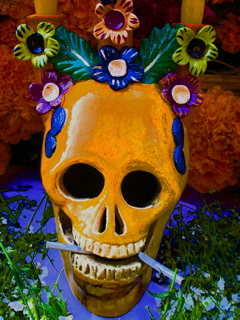 Dia de Los Muertos (Day of the Dead in English) is the most Mexican of all holidays and one that is appealing to many foreigners...but appalling to others. The holiday is celebrated on November 1st and 2nd throughout Mexico, and in Mexican communities in the US and other countries. Mexicans have a special relationship with death: they consider it the beginning of life. Like people everywhere, Mexicans fear death, but they also mock it, joke with it, tease it, dance with it, create art about it, and most of all honor it publicly. During the Days of the Dead, death is celebrated with beautiful, artful and touching traditional altars created for the occasion--in homes, businesses and cemetaries.
Dia de Los Muertos (Day of the Dead in English) is the most Mexican of all holidays and one that is appealing to many foreigners...but appalling to others. The holiday is celebrated on November 1st and 2nd throughout Mexico, and in Mexican communities in the US and other countries. Mexicans have a special relationship with death: they consider it the beginning of life. Like people everywhere, Mexicans fear death, but they also mock it, joke with it, tease it, dance with it, create art about it, and most of all honor it publicly. During the Days of the Dead, death is celebrated with beautiful, artful and touching traditional altars created for the occasion--in homes, businesses and cemetaries.
Increasingly, Muertos (death images) are found in folk art and housewares all year round. Dancing skeletons (known as calacas ) adorn the most beautiful Mexican style homes. San Miguel Designs, based in the colonial town by the same name, sells popular Muertos aprons and men's shirts imprinted with dancing calaca mariachis throughout the year. "One of my customers, a childhood friend of Carlos Santana, purchased a Calacas Shirt as a gift for him.", says founder/ owner Patrice Wynne. The spirited images of Days of the Dead began in the popular culture of Mexico but are now making their way into the US.
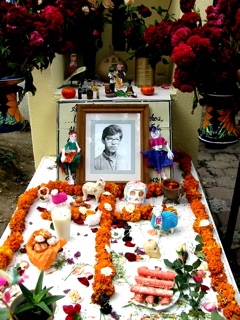 How did the holiday originate and why does food play such an important part of this fiesta? According to ancient Aztec culture, the soul lived after death and, forty days after death, returned to earth for one day of remembrance each year. They were seeking nourishment and community, finding their way back home by the scent of their favorite foods. In the pre-Hispanic cultural view, life-death are the same reality, and all of life is engaged in a perpetual process of creation and destruction. In the times of the Aztec, the maximum aspiration was a glorious death. The most honored death, la muerte florida or the flowering death, was to die in combat as an Aztec warrior, by ritual sacrifice to the gods, or by giving birth for women. The Aztec honored their dead with fiestas and rituals connected with the harvest season as death is the beginning of the seasonal life cycle. The ancient ritual calendar, still used today, called for celebrations of deceased children on November 1 (The Little Feast for the Dead) and for adults on November 2 (The Great Feast for the Dead).
How did the holiday originate and why does food play such an important part of this fiesta? According to ancient Aztec culture, the soul lived after death and, forty days after death, returned to earth for one day of remembrance each year. They were seeking nourishment and community, finding their way back home by the scent of their favorite foods. In the pre-Hispanic cultural view, life-death are the same reality, and all of life is engaged in a perpetual process of creation and destruction. In the times of the Aztec, the maximum aspiration was a glorious death. The most honored death, la muerte florida or the flowering death, was to die in combat as an Aztec warrior, by ritual sacrifice to the gods, or by giving birth for women. The Aztec honored their dead with fiestas and rituals connected with the harvest season as death is the beginning of the seasonal life cycle. The ancient ritual calendar, still used today, called for celebrations of deceased children on November 1 (The Little Feast for the Dead) and for adults on November 2 (The Great Feast for the Dead).
Today, Dia De Los Muertos is a time set aside in Mexican families to honor their deceased love ones. It is important for families to be in a good relationship with their dead relatives for it is the dead that bring good fortune to the living. The visible preparations for Dia de Los Muertos begin in mid-October. In the homes, much effort goes into preparing the altar, known as an Ofrenda , and preparing traditional foods. Altars are created using artifacts carried over from pre-Colombian Aztec times but still relevant in modern times: candles, masks, flowers, sugar skulls, papel picado, skeletons, traditional foods, favorite drinks and vices, copal incense, bread, handmade toys, children's clothing, household saints and musical instruments.
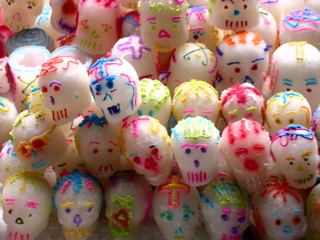 The journey from Mictlan , the Aztec name of the Underworld, is long, tiring and treacherous. A wash basin, towel, soap and a mirror are placed near the Ofrenda so the departed spirit can cleanse themselves before joining in the festivities. A glass of water is always set out for the soul to quench its thirst. Other beverages served at the feast are fruit-flavored water ( agua fresca ) and the popular hot corn drink flavored with chocolate sold on the streets of Mexico, atole . Decorated sugar skulls are an essential part of the altar and, in the weeks preceding the holiday, women are working round the clock to prepare the sugar creations found in the famous sugar skull markets of Patzcuaro and San Miguel de Allende. The names of the departed are written on the sugar skulls, but also the names of the living, to remind us all of life's fragility. Small sugar skeleton figures of the person’s trade or whimsical cartoon characters for the dead child are sold in the mercados . Sweets are particularly essential for the muertitos or little dead ones, along with newly purchased toys. The abundance of coconut candy, sugar cane, and pumpkin cooked in brown sugar syrup ( calabaza en tacha ) ensure that muertitos will need to visit a dentist upon their return to the other side!
The journey from Mictlan , the Aztec name of the Underworld, is long, tiring and treacherous. A wash basin, towel, soap and a mirror are placed near the Ofrenda so the departed spirit can cleanse themselves before joining in the festivities. A glass of water is always set out for the soul to quench its thirst. Other beverages served at the feast are fruit-flavored water ( agua fresca ) and the popular hot corn drink flavored with chocolate sold on the streets of Mexico, atole . Decorated sugar skulls are an essential part of the altar and, in the weeks preceding the holiday, women are working round the clock to prepare the sugar creations found in the famous sugar skull markets of Patzcuaro and San Miguel de Allende. The names of the departed are written on the sugar skulls, but also the names of the living, to remind us all of life's fragility. Small sugar skeleton figures of the person’s trade or whimsical cartoon characters for the dead child are sold in the mercados . Sweets are particularly essential for the muertitos or little dead ones, along with newly purchased toys. The abundance of coconut candy, sugar cane, and pumpkin cooked in brown sugar syrup ( calabaza en tacha ) ensure that muertitos will need to visit a dentist upon their return to the other side!
Traditional meals composed of favorite foods of the deceased are set out in various clay pots. They might include the finest ears of the harvest corn, home made tamales, rich mole chicken, chili adobe sauce, red rice, handrolled enchiladas, fresh tortillas and delicious fruits of the season. A dish of salt, symbolizing purification, is always included. Rich egg breads ( pan de muertos ) made in the shape of bodies ( animas ) are placed on the altars. They are decorated with sugar angels or baker’s clay faces of Jesus and other saints and with the names of the deceased. It is believed that the soul can taste the food through the smells and that the spirit consumes the essence of the meal. When the spirit has had its fill, the feast is then shared with relatives and visiting friends.
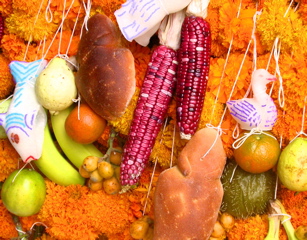 The Ofrenda may be set up on a table or on a straw mat on the floor. Every item on the altar has significance. The yellow marigold, known by its Aztec name of zempoaxochitl ( flor de muerto ), is the primary flower, and markets are transformed into brilliant fields of yellow in the days leading up to the holiday. It is believed that the marigold carries the smell of death, a smell that leads the dead home. Other traditional flowers of the holiday are baby’s breath ( nube ) and wine colored coxcomb ( magenta terciopelo ). A copal incense burner, placed in the center, burns with a pungent woody aroma that leads the dead, with their heightened sense of smell to the Ofrenda . Images of favorite saints and candles decorated with ribbons are placed on the altar, one candle for each deceased family member. As each candle is lit the names of the departed are called out, as if to say "Come back home, my son, your family awaits you". The flame of the candle lights the way to guide the deceased soul home. Family photographs and objects of value to the departed are set out to give the dead the feeling of being home again. The dead care about the materials things of their former life and are comforted by their favorite possessions. Sandals ( huaraches ), shawls ( rebozos ), straw hats, saddles and carving tools are some of the items you might see on a campesino altar. Silver jewelry, silk shawls, high heels and a statue of a bullfighter are examples of objects found on an urban altar. Newly pressed clothes are placed on a chair below a wall mirror. Just as in life, each soul has a bit of vanity and wants to be admired during the fiesta.
The Ofrenda may be set up on a table or on a straw mat on the floor. Every item on the altar has significance. The yellow marigold, known by its Aztec name of zempoaxochitl ( flor de muerto ), is the primary flower, and markets are transformed into brilliant fields of yellow in the days leading up to the holiday. It is believed that the marigold carries the smell of death, a smell that leads the dead home. Other traditional flowers of the holiday are baby’s breath ( nube ) and wine colored coxcomb ( magenta terciopelo ). A copal incense burner, placed in the center, burns with a pungent woody aroma that leads the dead, with their heightened sense of smell to the Ofrenda . Images of favorite saints and candles decorated with ribbons are placed on the altar, one candle for each deceased family member. As each candle is lit the names of the departed are called out, as if to say "Come back home, my son, your family awaits you". The flame of the candle lights the way to guide the deceased soul home. Family photographs and objects of value to the departed are set out to give the dead the feeling of being home again. The dead care about the materials things of their former life and are comforted by their favorite possessions. Sandals ( huaraches ), shawls ( rebozos ), straw hats, saddles and carving tools are some of the items you might see on a campesino altar. Silver jewelry, silk shawls, high heels and a statue of a bullfighter are examples of objects found on an urban altar. Newly pressed clothes are placed on a chair below a wall mirror. Just as in life, each soul has a bit of vanity and wants to be admired during the fiesta.
The Aztecs used papel picado or paper banners in their religious rituals and this tradition is still carried out today. Curtains of papel de china picado are hung behind the altar in designs cut-out with skeletons, flowers, birds, and coffins. Purple banners represents mourning and hot pink or bright orange banners signify the joyful return of the departed to the land of the living. In many part of Mexico, families spread a floral carpet on the ground leading to their home so that the spirit does not get lost along the way. A central idea behind the creation of the Ofrenda is to share with the dead the pleasures of life. Pulque, beer or tequila are served as reminders of the good times on earth. A former smoker will be treated with his/her favorite brand of cigarettes and Coca Cola is inevitable. The Ofrenda is an offering or helping force, and a visual expression, without judgment, of the gratitude, love and veneration the family feels for the visiting spirit of their relative.
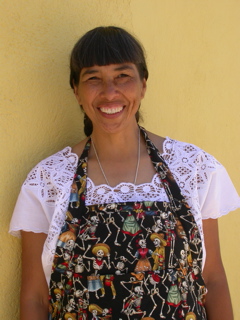 In the Mexican tradition, no soul should be left unacknowledged. October 27th is known as the Day of the Orphaned Souls. The souls with no living relatives to welcome them are received by the community with bread and water hung on doors. October 28th is the day of the Accidentados , those souls that died in accidents or violent deaths. October 30th is the day to welcome the souls of children that died in childbirth before being baptized, los ninos limbos . October 31 is the day of the Angelitos , souls of infant children that died in infancy, but that have been baptized and are thus free of sin. An Aztec legend tells of a paradise in heaven where a tree of human breasts provides mothers' milk for the Angelitos . The Angelitos enter the earth at noon on this day and must depart by noon the following day, November 1.
In the Mexican tradition, no soul should be left unacknowledged. October 27th is known as the Day of the Orphaned Souls. The souls with no living relatives to welcome them are received by the community with bread and water hung on doors. October 28th is the day of the Accidentados , those souls that died in accidents or violent deaths. October 30th is the day to welcome the souls of children that died in childbirth before being baptized, los ninos limbos . October 31 is the day of the Angelitos , souls of infant children that died in infancy, but that have been baptized and are thus free of sin. An Aztec legend tells of a paradise in heaven where a tree of human breasts provides mothers' milk for the Angelitos . The Angelitos enter the earth at noon on this day and must depart by noon the following day, November 1.
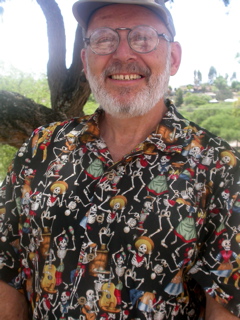 At noon on November 1st, church bells toll for the arrival of the elder traveling spirits, known as the Faithful Dead. At sundown processions of families are seen arriving at the graveyard with abundant flowers, overflowing picnic baskets and battery-powered boom boxes for entertaining the souls. An all-night vigil of communion with the dead begins in the cemeteries filled with celebrants. Gravestone altars are being cleaned, fresh planted flowers are placed in the newly turned soil, and tombstones are given a fresh coat of colorful paint. Tombstones are extravagantly decorated with flowers, bread, foods and fruits. Families reminisce with their departed loved ones, recounting tales of events of the past year. Candles flicker and the scent of copal incense penetrates the air. The dead walk among the living, dancing to the music of live mariachis, or to their favorite romantic music played on boom boxes. Some families, more religiously inclined, pray the Rosary or read the Bible out loud at the grave. The following day the Fiesta continues in the social atmosphere of gossip, picnics, drinking and more mariachi music at the grave sites. The celebration is over by the evening of November 2, but the memories linger in the souls of the dead who can return to the afterlife, knowing that they have not been forgotten by those they love. VIVA MEXICO!
At noon on November 1st, church bells toll for the arrival of the elder traveling spirits, known as the Faithful Dead. At sundown processions of families are seen arriving at the graveyard with abundant flowers, overflowing picnic baskets and battery-powered boom boxes for entertaining the souls. An all-night vigil of communion with the dead begins in the cemeteries filled with celebrants. Gravestone altars are being cleaned, fresh planted flowers are placed in the newly turned soil, and tombstones are given a fresh coat of colorful paint. Tombstones are extravagantly decorated with flowers, bread, foods and fruits. Families reminisce with their departed loved ones, recounting tales of events of the past year. Candles flicker and the scent of copal incense penetrates the air. The dead walk among the living, dancing to the music of live mariachis, or to their favorite romantic music played on boom boxes. Some families, more religiously inclined, pray the Rosary or read the Bible out loud at the grave. The following day the Fiesta continues in the social atmosphere of gossip, picnics, drinking and more mariachi music at the grave sites. The celebration is over by the evening of November 2, but the memories linger in the souls of the dead who can return to the afterlife, knowing that they have not been forgotten by those they love. VIVA MEXICO!
![]()
Photo Credits: © Patrice Wynne
![]()
Maria Teresa Valenzuela is a lecturer and healer of Mexican-Indian descent, specializing in the rituals and traditional practices of Meso-America. She lives in San Miguel de Allende where she creates traditional altars and offers cemetery tours and altar building classes during the Days of the Dead. For information about her lectures, given in the US and Mexico, and to order Day of the Dead aprons and Calaca Mariachi men's shirts, go to www.sanmigueldesigns.com or call 1-510-295-4296.
Note: This information was accurate when it was published. Please be sure to confirm all rates and details directly with the businesses in question before making your plans.



